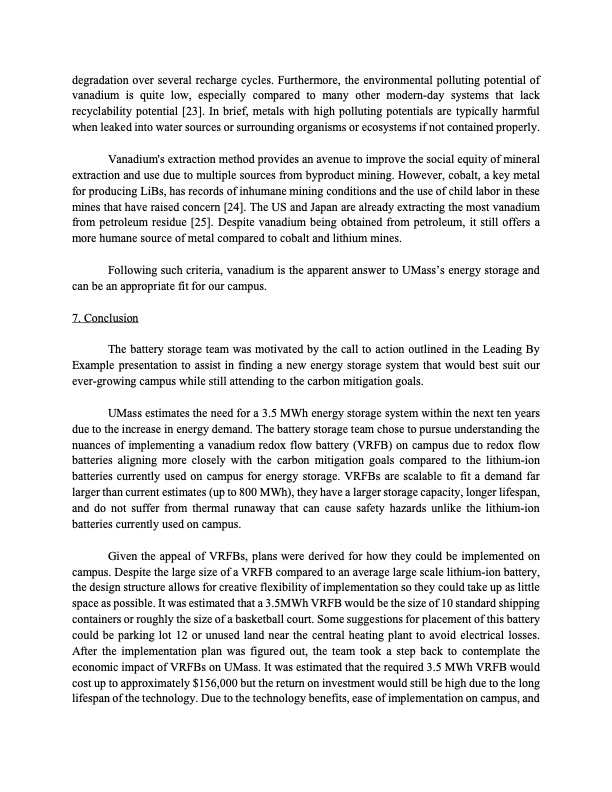
PDF Publication Title:
Text from PDF Page: 008
degradation over several recharge cycles. Furthermore, the environmental polluting potential of vanadium is quite low, especially compared to many other modern-day systems that lack recyclability potential [23]. In brief, metals with high polluting potentials are typically harmful when leaked into water sources or surrounding organisms or ecosystems if not contained properly. Vanadium's extraction method provides an avenue to improve the social equity of mineral extraction and use due to multiple sources from byproduct mining. However, cobalt, a key metal for producing LiBs, has records of inhumane mining conditions and the use of child labor in these mines that have raised concern [24]. The US and Japan are already extracting the most vanadium from petroleum residue [25]. Despite vanadium being obtained from petroleum, it still offers a more humane source of metal compared to cobalt and lithium mines. Following such criteria, vanadium is the apparent answer to UMass’s energy storage and can be an appropriate fit for our campus. 7. Conclusion The battery storage team was motivated by the call to action outlined in the Leading By Example presentation to assist in finding a new energy storage system that would best suit our ever-growing campus while still attending to the carbon mitigation goals. UMass estimates the need for a 3.5 MWh energy storage system within the next ten years due to the increase in energy demand. The battery storage team chose to pursue understanding the nuances of implementing a vanadium redox flow battery (VRFB) on campus due to redox flow batteries aligning more closely with the carbon mitigation goals compared to the lithium-ion batteries currently used on campus for energy storage. VRFBs are scalable to fit a demand far larger than current estimates (up to 800 MWh), they have a larger storage capacity, longer lifespan, and do not suffer from thermal runaway that can cause safety hazards unlike the lithium-ion batteries currently used on campus. Given the appeal of VRFBs, plans were derived for how they could be implemented on campus. Despite the large size of a VRFB compared to an average large scale lithium-ion battery, the design structure allows for creative flexibility of implementation so they could take up as little space as possible. It was estimated that a 3.5MWh VRFB would be the size of 10 standard shipping containers or roughly the size of a basketball court. Some suggestions for placement of this battery could be parking lot 12 or unused land near the central heating plant to avoid electrical losses. After the implementation plan was figured out, the team took a step back to contemplate the economic impact of VRFBs on UMass. It was estimated that the required 3.5 MWh VRFB would cost up to approximately $156,000 but the return on investment would still be high due to the long lifespan of the technology. Due to the technology benefits, ease of implementation on campus, andPDF Image | Power of Implementing a Vanadium Redox Flow Battery UMass

PDF Search Title:
Power of Implementing a Vanadium Redox Flow Battery UMassOriginal File Name Searched:
vanadiumredoxflowbatteryicons2paper.pdfDIY PDF Search: Google It | Yahoo | Bing
Salgenx Redox Flow Battery Technology: Salt water flow battery technology with low cost and great energy density that can be used for power storage and thermal storage. Let us de-risk your production using our license. Our aqueous flow battery is less cost than Tesla Megapack and available faster. Redox flow battery. No membrane needed like with Vanadium, or Bromine. Salgenx flow battery
| CONTACT TEL: 608-238-6001 Email: greg@salgenx.com | RSS | AMP |